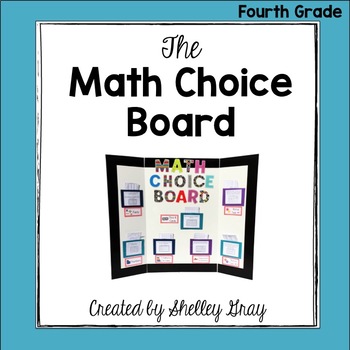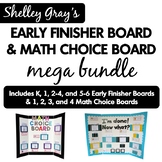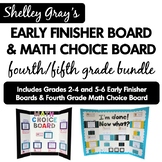Math Choice Board for 4th Grade
- Zip
Also included in
- This combo pack includes the Third Grade Math Choice Board, and the Fourth Grade Math Choice Board.Are you looking for a student-managed way to spiral your math curriculum and ensure that review happens all year long?Would you like to implement an engaging, curriculum-related choice board as a mathPrice $27.50Original Price $45.00Save $17.50
- Ready to engage your early finishers all year long? This Mega Bundle includes ALL Early Finisher Boards and Math Choice Boards that I currently have available. It also includes the specialty Early Finisher Board packages. Please see the bundle contents for all items that are included.If I create othPrice $114.99Original Price $189.00Save $74.01
- Ready to engage your early finishers all year long? This Mega Bundle includes ALL Early Finisher Boards and Math Choice Boards that I currently have available. It also includes the specialty Early Finisher Board packages. Please see the bundle contents for all items that are included.Price $73.99Original Price $102.00Save $28.01
- Ready to engage your early finishers all year long? This bundle includes the fourth grade Math Choice Board, the Grades 2-4 Early Finisher Board, and the Grades 5-6 Early Finisher Board. Most 4th grade teachers use the Grades 2-4 Early Finisher Board, but some prefer the more challenging 5/6 versionPrice $44.99Original Price $67.50Save $22.51
- This bundle includes all of the Math Choice Boards that are available. Once I have a 5th Grade version complete (hopefully by spring 2020), it will be added to this bundle as well.Enjoy!Shelley Graywww.ShelleyGrayTeaching.comPrice $51.99Original Price $90.00Save $38.01
Description
Are you looking for a student-managed way to spiral your math curriculum and ensure that review happens all year long?
Would you like to implement an engaging, curriculum-related choice board as a math station in your classroom?
Do you need a way to motivate your students when they first arrive in the classroom, at the beginning of class, or when they finish their work early?
I am so excited to introduce you to the Math Choice Board!
Several years ago, I created The Early Finisher Board – a solution for the fast finishers in your classroom. Over the years, thousands of people have successfully used that resource to motivate and engage their students. However, I have literally received hundreds of requests for something similar that focuses on Math only.
This is where The Math Choice Board comes in!
The Math Choice Board is similar to The Early Finisher Board in that it allows students to choose which activities they do, and when they do them. This board consists of seven sections: Facts, Numbers, Dice & Cards, Patterns & Data, Measurement & Geometry, and two Bonus Tasks.
Each section contains an engaging, curriculum-related activity to engage your students. The tasks are switched out regularly so that your students always have new tasks to choose from!
The Math Choice Board is designed to promote:
- a method of spiraling the curriculum so that students receive continuous review of previously learned skills
- organization and independence
- freedom to choose based on personal preferences
- differentiation based on interests
- success for a wide variety of ability levels within your diverse classroom
- student engagement
- pride and excitement
Ways to Use Your Math Choice Board
There are many ways to use the Math Choice Board within your classroom. You might choose to use it as:
- a Math Station or center. When students are at the Choice Board center, allow them to pick whichever activities they want from the board. This will create a sense of power and control for your students.
- a Math Warm-Up before math class begins
- a way of engaging your early finishers. Have your students choose tasks from the Math Choice Board when they finish their work, rather than simply reading or working on homework
- morning work upon arriving at school. When your students arrive in the classroom in the morning, have them work on the Math Choice Board. This will enhance predictability, routine, and organization first thing in the morning.










